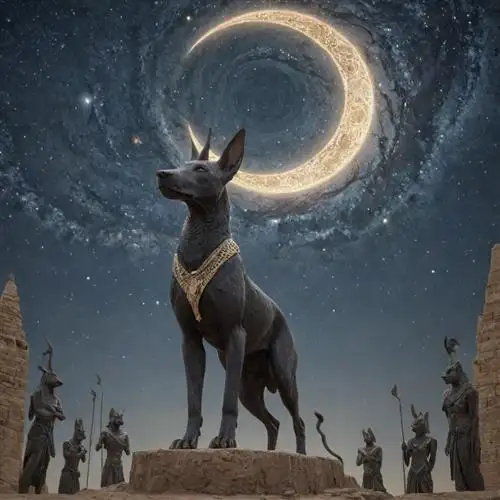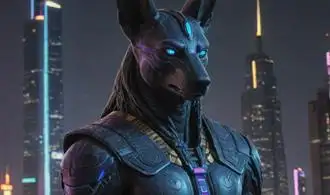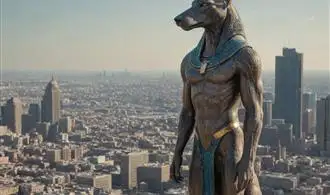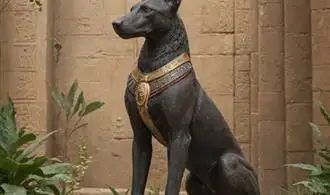
The Origins of Anubis Iconography
Anubis, the jackal-headed deity of ancient Egyptian mythology, has long been a subject of fascination for scholars and enthusiasts alike. The iconography associated with this enigmatic figure holds a wealth of insights into the beliefs and practices of the ancient Egyptians. To delve into the origins of Anubis iconography is to uncover a rich tapestry of symbolism, cultural significance, and the evolution of divine representation.
The earliest depictions of Anubis date back to the Predynastic period, where the jackal-like creature was associated with the necropolis and the embalming process. This ancient connection between Anubis and the afterlife is believed to have its roots in the observation of jackals and other canine species that were often found scavenging in the desert necropolis. The jackal's natural habitat and behavior in these sacred burial grounds likely contributed to the deity's role as a guide and protector of the dead.
As the ancient Egyptian civilization developed, the iconography of Anubis became more complex and nuanced. The jackal-headed figure was often portrayed in a seated or standing position, holding the crook and flail, symbols of kingship and authority. In some instances, Anubis was depicted as a full jackal, reflecting the animal's integral role in the funerary rituals and the afterlife journey of the deceased.
One of the most significant evolutions in Anubis iconography occurred during the New Kingdom, when the deity's association with mummification and the embalming process became more prominent. Anubis was often depicted alongside the embalming table, overseeing the meticulous process of preparing the deceased for the afterlife. This visual representation reinforced Anubis' role as the guardian of the dead and the one responsible for ensuring a successful transition to the next world.
Furthermore, the iconography of Anubis incorporated additional symbolic elements over time, such as the ankh (the symbol of life) and the Was scepter (a symbol of power and dominion). These additions further solidified Anubis' position as a multifaceted deity, with responsibilities ranging from the protection of the dead to the facilitation of the afterlife journey.
The Evolving Representations of Anubis
Anubis, the jackal-headed deity of ancient Egyptian mythology, has been depicted in a variety of forms throughout history, each iteration reflecting the evolving beliefs and perspectives of the culture that revered him. From his earliest representations as a pure jackal to his later depictions as a humanoid figure with a jackal head, the iconography of Anubis has undergone a fascinating transformation, shedding light on the changing nature of this enigmatic deity.
In the earliest known representations, Anubis was portrayed as a simple jackal, a reflection of his origin as a funerary deity associated with the embalming and mummification process. The jackal was a common sight in the desert regions of ancient Egypt, and its association with the dead and the underworld made it a natural choice for the guardian of the necropolis. This early, animalistic depiction of Anubis emphasized his primal connection to the natural world and his role as a protector of the dead.
As Egyptian civilization evolved, the iconography of Anubis began to incorporate more humanistic elements. Gradually, the deity was depicted with a human body and a jackal head, a hybrid form that combined the bestial and the divine. This transition reflected a growing understanding of Anubis as a complex and multifaceted deity, one who embodied both the earthly and the celestial realms. The jackal head remained a crucial component of his iconography, symbolizing his continued association with the natural world and the mysteries of the afterlife.
In some later representations, Anubis was depicted entirely as a human figure, with only subtle references to his jackal heritage, such as the inclusion of jackal ears or a jackal-like nose. This shift towards a more humanized representation of the deity may have been influenced by the growing importance of the cult of Osiris, the ruler of the underworld, with whom Anubis was closely associated. As the role of Anubis became increasingly tied to the judgment and protection of the dead, his iconography evolved to reflect a more anthropomorphic and judicial aspect.
The Significance of Anubis in Egyptian Funerary Rites
Anubis, the jackal-headed deity, held a pivotal role in the intricate web of Egyptian funerary rituals and beliefs. As the god of embalming and the protector of the dead, Anubis was a central figure in the journey of the deceased from this world to the next.
One of the primary responsibilities of Anubis was the mummification process. He was believed to have taught the art of embalming to the ancient Egyptians, and his presence was integral to the successful preservation of the body. Anubis would oversee the elaborate process, ensuring that the deceased was properly prepared for the afterlife.
During the mummification rites, Anubis would lay the body on the embalming table and perform the necessary rituals and procedures to purify and protect the deceased. This included the removal of the internal organs, which were placed in canopic jars under the watchful gaze of Anubis. The body was then carefully wrapped in linen, with Anubis responsible for the placement of amulets and other protective objects within the wrappings.
Anubis also played a crucial role in the funerary procession and the final rites performed at the tomb. He would accompany the deceased on their final journey, ensuring their safe passage to the afterlife. During the Opening of the Mouth ceremony, Anubis would touch the deceased's mouth and eyes, symbolically restoring their senses and allowing them to breathe and see in the afterlife.
Moreover, Anubis was believed to be the guardian of the necropolis, the sacred burial grounds where the dead were laid to rest. He was responsible for protecting the tombs and the souls of the deceased, guarding them from any harm or disturbance.
The Symbolic Associations of Anubis Iconography
Anubis, the ancient Egyptian jackal-headed deity, was a figure of immense significance in the pantheon of Egyptian gods. His iconography, replete with symbolic meaning, offers profound insights into the beliefs and rituals of this ancient civilization. At the heart of Anubis' symbolism lies his role as the guardian of the dead, the embalmer, and the psychopomp - the guide who leads the deceased into the afterlife.
The jackal-headed representation of Anubis is not merely a fanciful depiction, but a deliberate choice rooted in deep symbolic significance. The jackal, a scavenger that frequents cemeteries and burial grounds, was believed to possess a keen sense of the afterlife. Anubis' jackal-like visage was therefore a tangible manifestation of his domain over the realm of the dead and his intimate connection with the mysteries of the beyond.
Furthermore, the color black, often associated with Anubis' iconography, was symbolic of the fertile soil of the Nile delta, as well as the color of the mummified body. This dual association with both the earth and the deceased solidified Anubis' role as the guardian of the transition between life and death, the liminal space where the physical and spiritual worlds intersected.
Anubis' iconography also often depicts him holding a was scepter, a symbol of power and dominion, and the crook and flail, emblems of kingship and authority. These symbolic accessories underscore Anubis' elevated status within the Egyptian pantheon, his importance as a deity who presided over the most sacred of rituals and the most fundamental of human experiences - the journey from life to the afterlife.
To fully appreciate the depth of Anubis' iconography, one must also consider his association with the embalming process. As the patron of embalmers, Anubis was believed to oversee the mummification of the deceased, ensuring the preservation of the physical body and its readiness for the afterlife. The intricate rituals and procedures involved in mummification were imbued with Anubic symbolism, making Anubis a central figure in the Egyptian conceptualization of death and the hereafter.
The Enduring Legacy of Anubis Iconography
Anubis, the ancient Egyptian god of the dead, is one of the most iconic and enduring figures from the pantheon of ancient Egyptian deities. His distinct iconography, characterized by the jackal-headed figure, has captivated the imagination of scholars, artists, and the general public for centuries. The enduring legacy of Anubis iconography can be attributed to its deep symbolic significance, its evolution over time, and its continued relevance in modern cultural representations.
The symbolic significance of Anubis iconography is multi-layered and profound. As the god responsible for the embalming and protection of the dead, Anubis was closely associated with the process of mummification and the transition from life to the afterlife. His jackal-headed form is believed to represent his role as the guardian of the necropolis, the ancient Egyptian burial grounds. The black color of his skin is often interpreted as a reference to the fertile soil of the Nile River, symbolizing the regenerative power of death and rebirth.
Over the centuries, the iconography of Anubis has evolved and adapted to changing cultural and artistic influences. During the New Kingdom period (1550-1069 BCE), Anubis was often depicted in a more naturalistic style, with a greater emphasis on the jackal-like features of his face and body. In later periods, such as the Ptolemaic and Roman eras, the iconography of Anubis became more stylized and symbolic, with the figure often represented in a more abstract, geometric manner.
Despite these changes, the enduring appeal of Anubis iconography can be seen in its continued presence in modern cultural representations. From ancient Egyptian artifacts to contemporary art, literature, and popular culture, the image of Anubis remains a potent symbol of the mysteries of death, the afterlife, and the enduring power of ancient Egyptian mythology. The jackal-headed figure has been featured in everything from ancient tomb paintings to Hollywood blockbusters, serving as a testament to the lasting impact of this iconic ancient Egyptian deity.
















